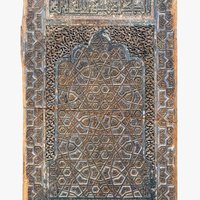Cenotaph of 1336 (before) from Central Asia, Uzbekistan
Item
Title
en
Cenotaph of 1336 (before) from Central Asia, Uzbekistan
Alternative Title
de
Kenotaph von 1336 (vor) aus Mittelasien, Usbekistan
Type
en
Cenotaph
de
Kenotaph
Region/Place of Production and Building
Mittelasien
Usbekistan
[Place of Production not identified]
[Building not identified]
Last Location
de
Buchara
en
Bukhara
Ownership and Custodial History
Bukhara, Art Museum
Bukhara, Mausoleum Saif ad-Din Bakharzi
Date of Inspection
1995-04
Description
de
Der Kenotaph des Saif ad-Din Bakharzi (gest. 1261) ist nur noch teilweise erhalten, es existieren noch eine Lang- und eine Schmalseite. Bei der Langseite handelt es sich aufgrund des Dekors (Nischenmotiv) sowie der Inschrift um die Haupt- bzw. die Schauseite. Die Längsseite wird durch insgesamt fünf hochrechteckige Felder gegliedert, die in der Breite variieren. Das Inschriftfeld im Zentrum ist etwas breiter als die beiden anschließenden Felder, die ein geometrisches Ornament auf der Grundlage eines sechszackigen Sterns, eingefaßt von Hexagonen (Sechsecken) aufweisen. Den Abschluß bilden außen zwei deutlich schmalere Felder mit vegetabilem Dekor. Die einzelnen Felder besitzen einen schmalen, z.T. mehrfach abgestuften Rahmen und sind voneinander durch eine endlos fortlaufende, stark stilisierte Ranke getrennt. Das Mittelfeld ist in Form einer Nische gestaltet, die deutlich an einen Mi?r?b bzw. eine “Mi?r?bnische en miniature“ erinnert. Das innere Feld zeigt eine Nische mit einem fünfpaßartigen Abschluß, die an beiden Seiten von eingebundenen Säulchen mit Krugkapitellen gerahmt ist. Die Schmalseite, die wie die Hauptseite Fehlstellen und Beschädigungen aufweist, besteht aus einem breiten Hauptpaneel mit geometrischem und zwei deutlich schmaleren Paneelen mit vegetabilem Dekor. Das Hauptfeld ist durch ein vergleichsweise kompliziertes geometrisches Dekorsystem mit einem 12-zackigen Stern im Zentrum geschmückt, das sich deutlich von den beiden Seitenfeldern der Schauseite unterscheidet. Ein solcher Dekorwechsel ist auch bei den späteren timuridischen Kenotaphen bzw. generell bei den timuridischen Holzarbeiten häufig zu beobachten.
en
The cenotaph of Saif ad-Din Bakharzi (d. 1261) is only partially preserved; only one long side and one short side remain. Due to its decoration (niche motif) and inscription, the long side is the main or display side. The long side is divided into a total of five upright rectangular fields that vary in width. The inscription field in the center is somewhat wider than the two adjacent fields, which feature a geometric ornament based on a six-pointed star, framed by hexagons. The outer border is formed by two significantly narrower fields with vegetal decoration. The individual fields have a narrow, sometimes multi-tiered frame and are separated from one another by an endless, highly stylized tendril. The central panel is designed in the form of a niche, clearly reminiscent of a mihrab or a "mihrab niche in miniature." The inner panel features a niche with a five-lobed end, framed on both sides by bound columns with jar capitals. The narrow side, which, like the main side, has missing parts and damage, consists of a wide main panel with geometric decoration and two significantly narrower panels with vegetal decoration. The main panel is decorated with a comparatively complex geometric decorative system with a 12-pointed star in the center, which differs significantly from the two side panels of the display side. Such a change in decoration is also frequently observed in later Timurid cenotaphs and in Timurid woodwork in general.
In Museum
en
A panel fragment in the V&A Museum, London (in the database, see below), is similar in its motif and decoration, but also shows clear differences. Most probably it was part of a cenotaph.
Inscription / Ornament
de
Nach Golombek/ Wilber (1988, 225, cat.no.1) ist der Kenotaph des Saif ad-Din Bakharzi datiert und wurde von seinem Enkel Yayha b. Ahmad (gest. 1336) gestiftet. Dafür finden sich jedoch auf dem Kenotaph selbst keine Anhaltspunkte. Es ist kein Datum für die Herstellung genannt, sondern nur das Todesdatum des Saif ad-Din Bakharzi (659 H./ 1261) sowie ein weiteres Datum, das unterschiedlich gelesen und interpretiert wurde (586 H./ 1190, u.U. sein Geburtsdatum durch Babajanov 1999, 195-97). Das Todesdatum des Yahya Bakharzi (1336), wenn wir ihn als Auftraggeber annehmen wollen, stellt also nur einen t.a.q. dar. Das Herstellungsdatum laesst sich also nur auf die Zeit zwischen 1261 uZ und 1336 uZ eingrenzen (siehe ausführlich Gierlichs, unpublizierter Artikel).
en
According to Golombek/Wilber (1988, 225, cat.no.1), the cenotaph of Saif ad-Din Bakharzi is dated and was donated by his grandson Yayha b. Ahmad (d. 1336). However, there is no evidence of this on the cenotaph itself. No date of manufacture is given, only the date of death of Saif ad-Din Bakharzi (659 H./ 1261 CE) and another date that has been differently read and interpreted (586 H./ 1190 CE, prob. his date of birth by Babajanov 1999, 195-97). The date of death of Yahya Bakharzi (1336 CE), if we accept him as the commissioner, therefore represents only a t.a.q. The date of manufacture can therefore only be limited to the period between 1261 CE and 1336 CE (for details see Gierlichs, forthcoming).
de
Mihrab-Nische; 6SH6; 12SH12
en
Mihrab niche: 6SH6; 12SH12
Patron
Yahya b. Ahmad b. Saif ad-Din Bakharzi (gest. 1336)
Deceased
Saif ad-Din Bakharzi
Date of Production (Common Era/Hijra)
1261 - 1336 CE
before 1336 CE
after 1261 CE
Bibliographic Citation
Denike (1935), fig.9-11
Denike (1939), 123-24, Abb. 118-11 (alte Photographie)
Rempel/ Pugachenkova (1965) Abb. 289
Albaum/ Brentjes (1978), Taf.34
Pugachenkova/ Khakimov (1988) Taf.14 (Din A3)
Babajanov (1999) 195-197, Taf.7
Gierlichs (forthcoming)
Dimensions
Height: 147,5 cm
Width: 251,5 cm
Depth: 135,5 cm
Physical Details
en
wood, coloured: red, blue black, and gold
de
Rahmenfüllungskonstruktion
en
Frame infill construction
en
Depth of Relief: 0,5 cm
Internal Notes
It is rather unlikely that the V&A panel has been the main central panel of the missing large back side of this cenotaph. Control measurements should be taken.
